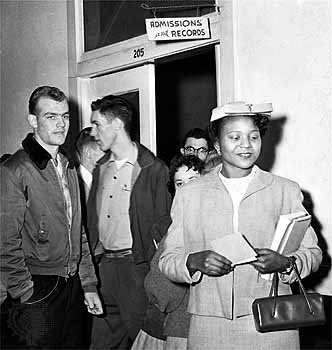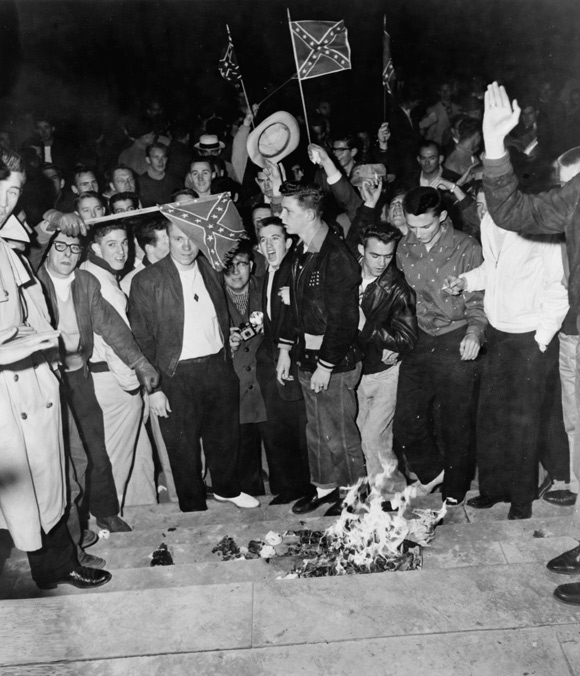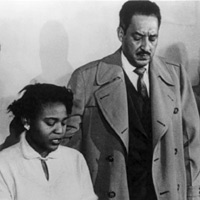Autherine Lucy
From fifties
Contents |
[edit] Autherine Lucy vs. the University of Alabama
[edit] In the beginning...
On October 5, 1929, Autherine Lucy was born in Shiloh, Alabama. Autherine was the last of ten children to Minnie Hosea Lucy and Milton Cornelius Lucy. The Lucy’s were self-sustaining farmers, living off the crops they produced. Autherine later admitted to never feeling exceptionally poor or the hardships of the depression, for her family was always able to provide for itself. She attended Shiloh elementary and later graduated from high school at Linden Academy.
Autherine’s undergraduate career was relatively free from turmoil. She first attended Selma University, a two-year school the equivalent to a contemporary junior college. After Selma she transferred to Miles College, an all-black school in Fairfield, Alabama. At Miles she would meet Hugh L. Foster, who she would later marry, and graduate in 1952 with a B.A. in English and aspirations of becoming a teacher.
[edit] The First Step
[edit] Pollie Anne Meyers and influences
While at Miles College, Autherine would meet an individual that would forever shape her life and lead her to be a known figure in Civil Rights history. Pollie Anne Meyers was also a student at Miles, and once introduced to each other, Pollie and Autherine became fast friends. Unlike the reserved nature of Autherine, Meyers was gregarious and displayed a confidence Autherine secretly admired. Also unlike Lucy, Meyers was slightly active in and idealistic about the injustices of the Jim Crow segregated south. Meyers had two part-time jobs at the time, one as a secretary for the local NAACP chapter. Most importantly, she also worked at the Birmingham World, a black publication, where she was able to gain experience in journalism, the career she was aspiring towards. The man who gave Meyers the confidence to pursue journalism was Emory Jackson, the editor of the Birmingham World. Courageous, and not afraid to blend personal motives with political stances, Jackson was an instrumental figure in standing up to local racism. His publication was not shy on reporting racial hate crimes on blacks by whites in the area, gaining him notoriety as controversial character of civil rights in the area. Later, Jackson would be key Lucy’s case against the University of Alabama by raising money to pay for the lawyer fees. With the influence of Jackson and a dream in her heart, Meyers was determined to get a masters degree in journalism. At the time, the University of Alabama was the only state institution that offered the degree.
[edit] While the irons hot...
Like every other college in the south, the University of Alabama was not integrated in the early 1950’s. The 1896 U.S. Supreme Court case of Plessy vs. Ferguson, that legalized segregation on the grounds of “separate but equal” was still in tact. However, change was in the air. The NAACP, led by Charles Houston and his protégée Thurgood Marshall, had been attacking segregation at the school level. The NAACP, finding that numerous states did not offer law schools for blacks, was winning many cases. Instead of creating law institutions or integrating the presently segregated ones, states were forced to pay out of state costs for black students to attend integrated colleges in the north. In the culture of Jim Crow, this measure was viewed as temporary relief until the federal court finally banned segregation of schools. With the influence of Jackson, Meyers knew now was the time to apply to the University of Alabama. Pollie Anne Meyers was determined, but regional NAACP director Ruby Hurley advised her that if she was going to go through with it, she should find a friend to go along on the basis of moral support. Lucy agreed, for with a graduate degree in Library Science from the University of Alabama, she knew her job opportunities would be endless. With that, and discovered attention from the NAACP, “things just happened”.
[edit] Locked and Loaded
The NAACP, led by lawyer Arthur Shores, accepted the case of Meyers and Lucy. Shores, who would be the local law representative by the NAACP, knew that the courts would doubt the sincerity of Lucy and Meyers to pursue their education if they were backed by the NAACP. Shores deliberately tried to remove any suspecting credibility by post dating the Meyers and Lucy applications for September 4, 1952 and mailed them the same day. Only after the two were denied admissions did they contact Shores and the NAACP on September 24. This smoke screen was necessary to show the authenticity of Meyers’ and Lucy’s desire for an education, not a publicity stunt. As anticipated the girl’s were rejected. However, they were initially accepted on September 10, 1952, because the applications failed to ask about race. Only upon discovering their skin color did President Gallalee of the university decide to overturn their acceptance. Shores was prepared and ready to appeal the decision through the university, the state government, and federal government if needed. Confident the law was on his side, Shores believed not even time could prevent Lucy and Meyers from being admitted. Time, though, would play a significant factor.
[edit] "Calm before the Storm"
[edit] Stall, Stall, Stall
Arthur Shores decided to implement his own “deliberate speed” in fighting to get the University of Alabama’s denial of Lucy and Meyers overturned. He willingly chose to exhaust the university’s appeal process. With white southerners anticipating the inevitability of integration, this allowed the school president and board of trustees the only defense they and their culture had left: stalling. However, Shores needed did this intentionally for his own benefit for he needed time to smooth out a strategic plan with Thurgood Marshall and NAACP national office in New York. Shores and Marshall had hoped the university would “admit the students without legal action. However, this would be a miracle in Alabama” (Clark, 38). On June 6, 1953, with Brown vs. Board of Education in the immediate future, the university bought more time by announcing they were going to wait until U.S. Supreme Court made a final decision regarding school integration. Shores and Marshall knew the legal action was now their only choice. With more delaying tactics, a trial date would not be set until June 29, 1955, two years and nine months after Meyers and Lucy were officially denied. During this time Meyers moved to Detroit with family and took classes at Wayne State University, while Lucy remained in Alabama, working part-time jobs.
[edit] Clouds on the Horizon
E. Culpepper Clark, author of The Schoolhouse Door: Segregation’s Last Stand at the University of Alabama, defines the year of 1954 as “the calm before the storm” in the southeastern United States. As everyone had expected, the U.S. Supreme Court ruled that segregation in schools was unconstitutional. Clark states that this decision came as no surprise, and the fact that the court ruled it should be done with “all deliberate speed” meant that white resistance could continue to use delaying tactics with regards to integration. Furthermore, Clark asserts that the 1954 decision did not change race relations in the South, for blacks, though gaining optimism still remained subordinate in their societal roles. However, two events in 1955 would ignite racial tensions. First, the U.S. Supreme Court amended the Brown vs. Board decision and added an implementation decree. “Deliberate speed” was no longer acceptable, and federal government wanted to see rapid change. This was a slap in the face to the south: a culture built on the belief of states rights was now, just like during the build up to the Civil War, being dictated by the north what to do concerning their race issues. Second, Rosa Parks refused to give up her seat on a Montgomery bus, and a new non-violent form of protest, which gathered it’s strength in numbers, was being led by the charismatic Dr. Martin Luther King, Jr. The Civil Rights movement had begun, and blacks were gaining confidence. King gave a face, a voice, and a sense of hope. This struck fear into the white southern culture, for blacks were no longer remaining subordinate in their customary place. And where there is fear of the unknown, as Lucy would experience, violence is a consequence.
On June 29, 1955, the NAACP easily wins the trial, and Lucy and Meyers were ordered to be admitted to the University of Alabama. Shores argument was the historical “continual denying of continual deniance of blacks” by the university. Also, the judge, a moderate from Kentucky and respectful of southern tradition, was not about to go above the U.S. Supreme Court, which had ruled on Brown. Though victory was anticipated, even the NAACP was surprised at how quickly (only a day) the verdict had been reached. However, the battle was won, but the war was only heating up.
Clark believes that if the University of Alabama had not deliberately delayed confronting the trial of Lucy and Meyers, then the inevitable integration would have gone smoother. Instead, by waiting for a federal decision in 1954, which then allowed for the events of 1955 to occur, civil unrest was now gaining steam in Tuscaloosa. Had Lucy and Meyers not had to wait almost three years for their admittance, then hostility would have been limited. But by 1955, when the case was legally won, southern pride was beginning to be severely threatened, and the extremists would react.
[edit] Through the Door
[edit] From 2 to 1
Though the Pollie Anne Meyers and Autherine Lucy were now legally admitted, the universities board of trustees had secret plan to preserve segregation. In the case of Meyers, it was discovered that she had mothered a child out of wedlock. This was strictly against university admission policies, and legal at the time to deny admittance to anyone who’s “morals” were in question. However, instead of immediately informing Meyers of their legal right to deny her admittance, the trustees waited until the last possible hour: the day before Lucy and Meyers were set to register for classes. With this tactic, the trustees had hoped to scare Lucy, the introverted of the two, from not attending on her own. With tears in her eyes, Meyers would not let Lucy stop now. “She’s going… she’s going even if I have to go with her” (Clark, 56). Though on her own, Lucy marched on.
February 1, 1956, 12:53 p.m.: Autherine Lucy pays the University of Alabama treasurer, officially becoming the first African American to legally breach any Jim Crow barrier erected by the state of Alabama.
[edit] Links
- Contemporary issue regarding integration and the University of Alabama
- United States timeline of school integration
- http://www.americaslibrary.gov/cgi-bin/page.cgi/aa/leaders/marshallthrgd/lucy_1
- http://en.wikipedia.org/wiki/Autherine_Lucy
- http://www.stanford.edu/group/King/chronology/details/560206.htm




